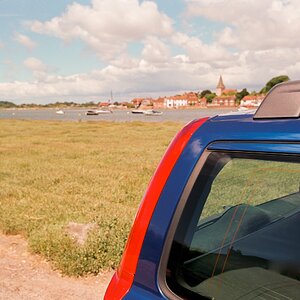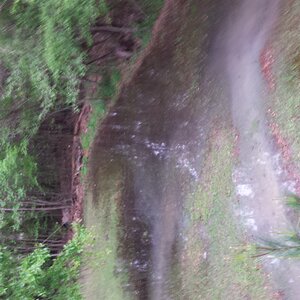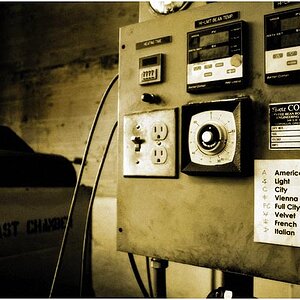VidThreeNorth
No longer a newbie, moving up!
- Joined
- Oct 21, 2016
- Messages
- 1,175
- Reaction score
- 214
- Can others edit my Photos
- Photos NOT OK to edit
I think it would be a good idea to accumulate microphone information in one topic, so here it is:
[2019-12-09 09:10 Added following 3 paragraphs:]
I am trying to put this information into some kind of order. As I have written before, there are objective measures which should give fairly consistent results from one tester to another, and there are subjective issues where differences boil down to the tester's preferences and particular situations. Because of this, if you check a broad range of reviews you will find that they do not always agree. So I have deliberately tried to link a variety of reviewers
I recommend starting with Max Yuryev's coverage of the Rode mono shotgun mics (see message #2 below). He covers most of the features and issues well and shows how to test them. He is also one of the only reviewers that pointed out that mounting the mics on the cameras did not always work well when using an EVF.
Unfortunately, he messed up his screen label at a few points in the video, but that should not cause you too much trouble. I do recommend that you have a piece of paper ready and pause the video and make notes.
[End of 2019-12-09 additions]
[2019-12-12 10:24 added rest of introduction]
After Max Yuryev's Rode review, then come back and watch Gerald Undone's look at two shotgun mics for studio use. This will give you a chance to look at the question of what is "good" sound in his particular situation?
The third video to watch is DSLR Videoshooter's video which goes into why he is generally not using Rode so much. It will fill in some of the currently available alternative products.
The forth video, which is Curtis Judd's look at two Azden microphones will overlap a bit of what Caleb Pike said about the Azden SMX-15 and start crossing over to two channel stereo mics with the Azden SMX-30
Finally, the fifth video looks at three stereo mics, giving an idea of what issues there are and three good products in that field. All these clips together give a fairly good introduction into the field of camera mounted microphones, and good starting points for research.
[End of 2019-12-12 additions]
[2019-12-09 09:15 Rewrite:]
I posted this before. It is Gerald Undone testing two microphones in his studio. It shows practical differences, but emphasizes that the results are fairly specific to this situation. Microphone analysis is both objective (self-noise, output level) and subjective (which "sounds better"?). Compared to Max Yuryev, who preferred a "flatter" response with less bass and a "crisper" more treble sound, Gerald Undone, at least in this case seems to like the more mid and bass response of the Diety. I would keep the other mic for the guitar. I do not like a "boom-y" mic for instruments.
[End of re-write]
"Should I Switch to This Microphone? // Deity S-Mic 2S",
- posted by "Gerald Undone" on Oct 1, 2019, [length 8:05]
""
Microphones compared:
Deity S-Mic 2S
Samson C02
Recent alternatives compared to equivalent Rode:
"Saying Goodbye to Rode?",
- posted by "DSLR Video Shooter" on Mar 12, 2019, [length 12:36]
""
[2019-12-09 13:14 added following:]
Mics Discussed (not much testing):
On Camera Mics:
Rode VideoMic Pro
Rode VideoMicro
Azden SMX-15
Diety D3 Pro
Movo VXR10
Studio Mics
Rode NTG2
Rode NTG4 (XLR)
Rode NTG4 Plus (USB rechargeable battery built-in)
Diety S Mic 2
Wireless
RodeLink
Sennheiser XSW Wireless System
Deity Connect Wireless System
Other "good" Rode Mics mentioned:
Rode NTG3
Rode NT5
Rode Lav
[2019-12-09 09:10 Added following 3 paragraphs:]
I am trying to put this information into some kind of order. As I have written before, there are objective measures which should give fairly consistent results from one tester to another, and there are subjective issues where differences boil down to the tester's preferences and particular situations. Because of this, if you check a broad range of reviews you will find that they do not always agree. So I have deliberately tried to link a variety of reviewers
I recommend starting with Max Yuryev's coverage of the Rode mono shotgun mics (see message #2 below). He covers most of the features and issues well and shows how to test them. He is also one of the only reviewers that pointed out that mounting the mics on the cameras did not always work well when using an EVF.
Unfortunately, he messed up his screen label at a few points in the video, but that should not cause you too much trouble. I do recommend that you have a piece of paper ready and pause the video and make notes.
[End of 2019-12-09 additions]
[2019-12-12 10:24 added rest of introduction]
After Max Yuryev's Rode review, then come back and watch Gerald Undone's look at two shotgun mics for studio use. This will give you a chance to look at the question of what is "good" sound in his particular situation?
The third video to watch is DSLR Videoshooter's video which goes into why he is generally not using Rode so much. It will fill in some of the currently available alternative products.
The forth video, which is Curtis Judd's look at two Azden microphones will overlap a bit of what Caleb Pike said about the Azden SMX-15 and start crossing over to two channel stereo mics with the Azden SMX-30
Finally, the fifth video looks at three stereo mics, giving an idea of what issues there are and three good products in that field. All these clips together give a fairly good introduction into the field of camera mounted microphones, and good starting points for research.
[End of 2019-12-12 additions]
[2019-12-09 09:15 Rewrite:]
I posted this before. It is Gerald Undone testing two microphones in his studio. It shows practical differences, but emphasizes that the results are fairly specific to this situation. Microphone analysis is both objective (self-noise, output level) and subjective (which "sounds better"?). Compared to Max Yuryev, who preferred a "flatter" response with less bass and a "crisper" more treble sound, Gerald Undone, at least in this case seems to like the more mid and bass response of the Diety. I would keep the other mic for the guitar. I do not like a "boom-y" mic for instruments.
[End of re-write]
"Should I Switch to This Microphone? // Deity S-Mic 2S",
- posted by "Gerald Undone" on Oct 1, 2019, [length 8:05]
""
Microphones compared:
Deity S-Mic 2S
Samson C02
Recent alternatives compared to equivalent Rode:
"Saying Goodbye to Rode?",
- posted by "DSLR Video Shooter" on Mar 12, 2019, [length 12:36]
""
[2019-12-09 13:14 added following:]
Mics Discussed (not much testing):
On Camera Mics:
Rode VideoMic Pro
Rode VideoMicro
Azden SMX-15
Diety D3 Pro
Movo VXR10
Studio Mics
Rode NTG2
Rode NTG4 (XLR)
Rode NTG4 Plus (USB rechargeable battery built-in)
Diety S Mic 2
Wireless
RodeLink
Sennheiser XSW Wireless System
Deity Connect Wireless System
Other "good" Rode Mics mentioned:
Rode NTG3
Rode NT5
Rode Lav
Last edited:













